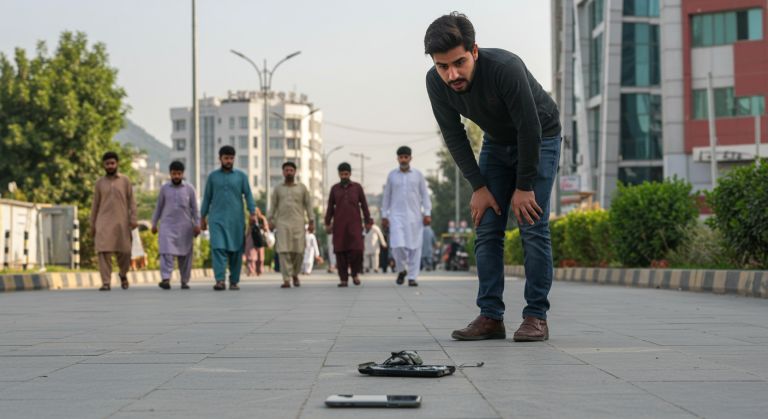Smartphone Addiction in Pakistani Youth: A Digital Disaster in the Making

In today’s hyper-connected digital world, smartphones have become an inseparable part of daily life. However, for a large portion of Pakistani youth, this dependency has quietly transformed into a full-blown addiction—raising concerns among parents, educators, and mental health experts.
Across Pakistan, teenagers and young adults are increasingly spending up to 10–12 hours daily on their phones, primarily on social media platforms such as TikTok, Instagram, Snapchat, and YouTube. This prolonged screen time is not only impacting their physical and mental health but is also contributing to a growing wave of academic underperformance, sleep disorders, and emotional disconnection.
The Growing Obsession
According to a recent survey conducted by the Pakistan Institute of Development Economics (PIDE), over 68% of youth aged 15–25 admit to being unable to spend even one hour without checking their phones. Mental health professionals now refer to this excessive reliance on smartphones as nomophobia, a condition marked by anxiety or discomfort when one is without their mobile device.
What started as a tool for communication and learning has now evolved into a source of digital escapism. With endless scrolling, constant notifications, and dopamine-driven content feeds, smartphones are being designed to hook users for maximum engagement.
Impact on Mental and Physical Health
Health experts are sounding the alarm on the dangerous health effects of excessive phone usage. Dr. Naila Farooq, a psychiatrist based in Lahore, noted, “We are seeing a disturbing rise in anxiety, depression, and attention-deficit issues among teens. Many cases are directly linked to excessive smartphone use, especially at night.”
Sleep deprivation is another growing concern. A large number of youth are staying awake past midnight, glued to their screens. Blue light emitted from phones disrupts natural sleep cycles, causing insomnia and fatigue during the day.
Physically, prolonged smartphone use is contributing to poor posture, eye strain, and even early symptoms of carpal tunnel syndrome. But perhaps the most worrying trend is social isolation. Young individuals are becoming more comfortable in virtual environments than in real-life interactions.
Academic and Social Decline
Teachers and school administrators have also raised red flags over declining student engagement and academic performance. Students are often distracted in classrooms, with many secretly using phones during lectures. Attention spans are shrinking, and the ability to focus on long-term tasks is rapidly eroding.
Furthermore, excessive smartphone use is damaging family relationships. Youth are increasingly retreating into digital spaces, avoiding family conversations and household responsibilities. “Dinner tables have turned silent. Everyone is scrolling instead of talking,” says Ahmed Bashir, a father of three teenagers from Karachi.
The Role of Social Media and Gaming
Social media platforms are designed with highly addictive features—endless feeds, likes, followers, and reels—making it difficult for users to log off. Meanwhile, mobile gaming, particularly battle royale games like PUBG and Free Fire, has become an obsession for many teens. These platforms use psychological tricks to keep players hooked, leading to unhealthy screen habits and even aggression.
This issue extends beyond the youth—many parents also face difficulty in controlling screen time and, ironically, exhibit similar phone-obsessed behaviors, inadvertently becoming negative role models for their children.
Efforts Toward Digital Discipline
Some schools in urban centers like Islamabad and Lahore have taken steps to control smartphone usage. Initiatives such as mobile-free environments, awareness seminars on screen-time management, and structured digital detox plans have been introduced to curb the growing dependency. However, implementation remains inconsistent across the country.
The Ministry of Information Technology has also launched awareness campaigns about responsible internet and mobile usage, but results have been modest. Experts believe that without nationwide digital literacy and parental guidance, change will be difficult.
Dr. Amir Shehzad, an education expert from Punjab University, suggested, “We need a multi-tiered approach—schools, families, tech companies, and policymakers must work together. Encouraging outdoor activities, sports, reading, and family bonding is critical.”
Is There a Way Out?
Breaking smartphone addiction requires effort and awareness. Psychologists recommend creating “phone-free hours,” turning off unnecessary notifications, using screen-time monitoring apps, and engaging in real-world hobbies. Parental controls and open family conversations about screen use can also help.
In the end, technology is not the enemy—excessive and unconscious use is. Smartphones can be powerful tools for learning, productivity, and connection—but only when used wisely.
As Pakistan’s youth stands at the crossroads of a digital future, the choice is clear: either master the technology or become its slave.



